浅析英文电影网络字幕翻译
- 格式:pdf
- 大小:112.23 KB
- 文档页数:1
![[英语,字幕,电影]浅谈英语电影字幕翻译](https://uimg.taocdn.com/b06e1f237c1cfad6185fa759.webp)
浅谈英语电影字幕翻译一、引言近年来随着对外文化交流的发展与深入,一大批优秀的外国影片被引进到中国,受到人们的喜爱。
大量国外影片的引进,带动了英语字幕翻译需求的增长,然而,关于英语电影字幕翻译的标准始终未有一个统一的标准,但由于影视作品是剧作者根据自身生活的经历或经验创造而成,反映了一定的社会文化背景,其语言对白具有不同于其他文体的显著特点。
因此,在对英语电影翻译时,应把握住其特点进行翻译。
二、英语电影字幕的语言特点1.口语性以剧情为主的影视作品一般主要是靠角色之间的互动来展开情节,这种互动一般以对话来呈现。
既然是对话,就是生活中浅显易懂的日常口语,即简短、直接、生动,并且含有较多的非正式语及俗语等。
2.文化性著名翻译家Nida 指出:语言是文化的一部分,任何文本的意义都有直接或间接地反映一个相应的文化,词语意义最终也只能在相应的文化中找到。
译制片本身就属于艺术的二度创作,目的就是向目的语观众介绍国外文化,促进民族文化的发展。
3.服务性英语字幕不是独立存在的。
它必须与影视作品的画面、声音等结合在一起才具有意义。
如果把一段字幕抽取出来,单看其内容,是无法了解其真正涵义的,而其最终目的决定了字幕的服务性的特点。
4.时空受限性既然字幕不可能独立于画面和声音而存在,这也就决定了其在时间停留和空间安排上都受到限制的特点。
一方面,它不可能像书本上的文字一样长久停留在同一处,静止不动。
随着与其语境相吻合的画面和声音的消失,它也必然消失,被下一句字幕所取代,即字幕瞬时性的本质。
另一方面,字幕的空间存在也受到较大限制。
影视剧最大的魅力就在于其图像与声音的完美结合。
字幕作为并非必要的一种后来添加物,其存在的前提便是不能对画面的整体视觉效果造成较大的破坏。
因此,字幕的排版也必须符合审美标准。
三、字幕翻译常用方法1.直译法由于不同国家的文化在大多数情况下是重叠的,所以原语言观众和目的语观众有相同或相似的认知环境。
在没有出现文化差异的情况下,直译足够帮助目的语观众获得最佳关联。
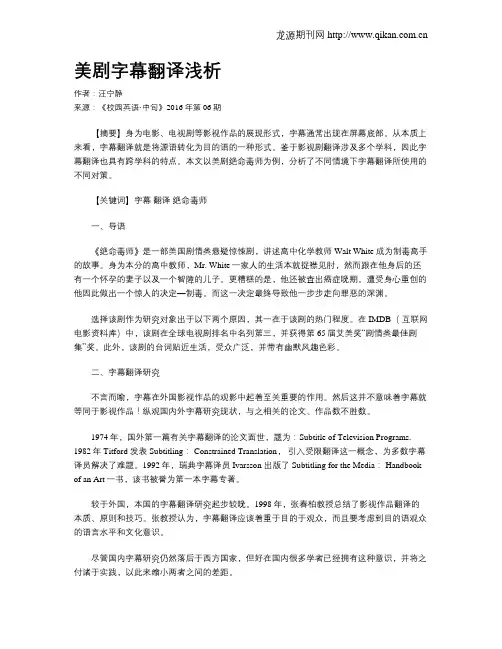
美剧字幕翻译浅析作者:汪宁静来源:《校园英语·中旬》2016年第06期【摘要】身为电影、电视剧等影视作品的展现形式,字幕通常出现在屏幕底部。
从本质上来看,字幕翻译就是将源语转化为目的语的一种形式。
鉴于影视剧翻译涉及多个学科,因此字幕翻译也具有跨学科的特点。
本文以美剧绝命毒师为例,分析了不同情境下字幕翻译所使用的不同对策。
【关键词】字幕翻译绝命毒师一、导语《绝命毒师》是一部美国剧情类悬疑惊悚剧,讲述高中化学教师Walt White成为制毒高手的故事。
身为本分的高中教师,Mr. White一家人的生活本就捉襟见肘,然而跟在他身后的还有一个怀孕的妻子以及一个智障的儿子。
更糟糕的是,他还被查出癌症晚期。
遭受身心重创的他因此做出一个惊人的决定—制毒。
而这一决定最终导致他一步步走向罪恶的深渊。
选择该剧作为研究对象出于以下两个原因,其一在于该剧的热门程度。
在 IMDB(互联网电影资料库)中,该剧在全球电视剧排名中名列第三,并获得第65届艾美奖“剧情类最佳剧集”奖。
此外,该剧的台词贴近生活,受众广泛,并带有幽默风趣色彩。
二、字幕翻译研究不言而喻,字幕在外国影视作品的观影中起着至关重要的作用。
然后这并不意味着字幕就等同于影视作品!纵观国内外字幕研究现状,与之相关的论文、作品数不胜数。
1974年,国外第一篇有关字幕翻译的论文面世,题为:Subtitle of Television Programs. 1982年Titford 发表Subtitling: Constrained Translation,引入受限翻译这一概念,为多数字幕译员解决了难题。
1992年,瑞典字幕译员Ivarsson 出版了Subtitling for the Media: Handbook of an Art一书,该书被誉为第一本字幕专著。
较于外国,本国的字幕翻译研究起步较晚。
1998年,张春柏教授总结了影视作品翻译的本质、原则和技巧。
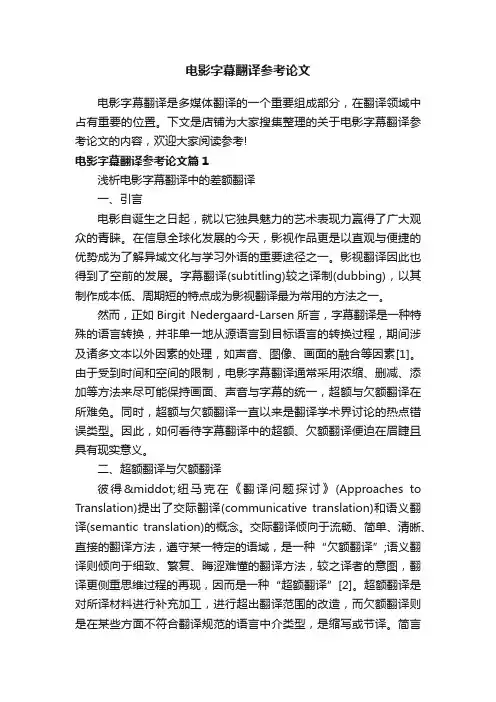
电影字幕翻译参考论文电影字幕翻译是多媒体翻译的一个重要组成部分,在翻译领域中占有重要的位置。
下文是店铺为大家搜集整理的关于电影字幕翻译参考论文的内容,欢迎大家阅读参考!电影字幕翻译参考论文篇1浅析电影字幕翻译中的差额翻译一、引言电影自诞生之日起,就以它独具魅力的艺术表现力赢得了广大观众的青睐。
在信息全球化发展的今天,影视作品更是以直观与便捷的优势成为了解异域文化与学习外语的重要途径之一。
影视翻译因此也得到了空前的发展。
字幕翻译(subtitling)较之译制(dubbing),以其制作成本低、周期短的特点成为影视翻译最为常用的方法之一。
然而,正如Birgit Nedergaard-Larsen所言,字幕翻译是一种特殊的语言转换,并非单一地从源语言到目标语言的转换过程,期间涉及诸多文本以外因素的处理,如声音、图像、画面的融合等因素[1]。
由于受到时间和空间的限制,电影字幕翻译通常采用浓缩、删减、添加等方法来尽可能保持画面、声音与字幕的统一,超额与欠额翻译在所难免。
同时,超额与欠额翻译一直以来是翻译学术界讨论的热点错误类型。
因此,如何看待字幕翻译中的超额、欠额翻译便迫在眉睫且具有现实意义。
二、超额翻译与欠额翻译彼得·纽马克在《翻译问题探讨》(Approaches to Translation)提出了交际翻译(communicative translation)和语义翻译(semantic translation)的概念。
交际翻译倾向于流畅、简单、清晰、直接的翻译方法,遵守某一特定的语域,是一种“欠额翻译”;语义翻译则倾向于细致、繁复、晦涩难懂的翻译方法,较之译者的意图,翻译更侧重思维过程的再现,因而是一种“超额翻译”[2]。
超额翻译是对所译材料进行补充加工,进行超出翻译范围的改造,而欠额翻译则是在某些方面不符合翻译规范的语言中介类型,是缩写或节译。
简言之,超额翻译是指译语文本承载了比源语文本更多的信息量,表述方式相对具体;而欠额翻译是指译语文本承载的信息量小于源语文本,译语文本更加概括[3]。
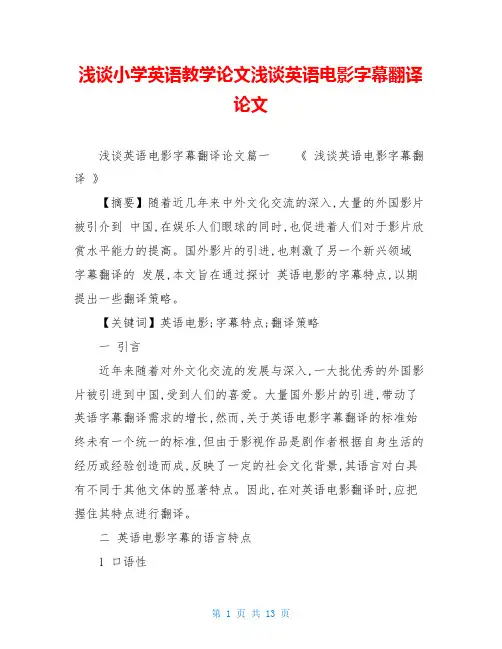
浅谈小学英语教学论文浅谈英语电影字幕翻译论文浅谈英语电影字幕翻译论文篇一《浅谈英语电影字幕翻译》【摘要】随着近几年来中外文化交流的深入,大量的外国影片被引介到中国,在娱乐人们眼球的同时,也促进着人们对于影片欣赏水平能力的提高。
国外影片的引进,也刺激了另一个新兴领域字幕翻译的发展,本文旨在通过探讨英语电影的字幕特点,以期提出一些翻译策略。
【关键词】英语电影;字幕特点;翻译策略一引言近年来随着对外文化交流的发展与深入,一大批优秀的外国影片被引进到中国,受到人们的喜爱。
大量国外影片的引进,带动了英语字幕翻译需求的增长,然而,关于英语电影字幕翻译的标准始终未有一个统一的标准,但由于影视作品是剧作者根据自身生活的经历或经验创造而成,反映了一定的社会文化背景,其语言对白具有不同于其他文体的显著特点。
因此,在对英语电影翻译时,应把握住其特点进行翻译。
二英语电影字幕的语言特点1 口语性以剧情为主的影视作品一般主要是靠角色之间的互动来展开情节,这种互动一般以对话来呈现。
既然是对话,就是生活中浅显易懂的日常口语,即简短、直接、生动,并且含有较多的非正式语及俗语等。
2 文化性著名翻译家Nida 指出:语言是文化的一部分,任何文本的意义都有直接或间接地反映一个相应的文化,词语意义最终也只能在相应的文化中找到。
译制片本身就属于艺术的二度创作,目的就是向目的语观众介绍国外文化,促进民族文化的发展。
3 服务性英语字幕不是独立存在的。
它必须与影视作品的画面、声音等结合在一起才具有意义。
如果把一段字幕抽取出来,单看其内容,是无法了解其真正涵义的,而其最终目的决定了字幕的服务性的特点。
4 时空受限性既然字幕不可能独立于画面和声音而存在,这也就决定了其在时间停留和空间安排上都受到限制的特点。
一方面,它不可能象书本上的文字一样长久停留在同一处,静止不动。
随着与其语境相吻合的画面和声音的消失,它也必然消失,被下一句字幕所取代,即字幕瞬时性的本质。
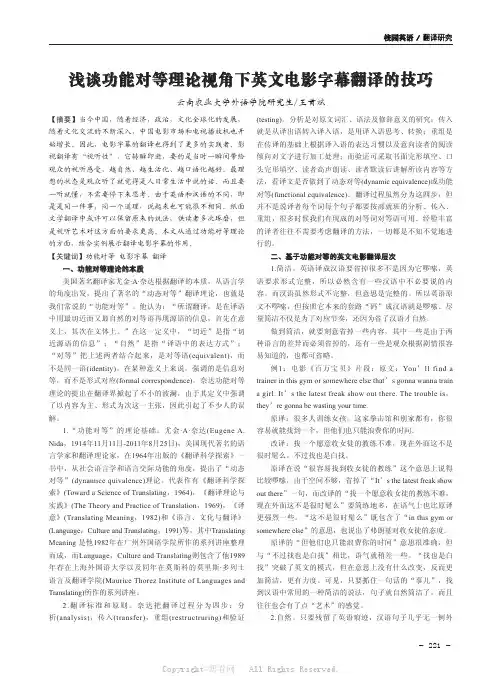
校园英语 / 翻译研究浅谈功能对等理论视角下英文电影字幕翻译的技巧云南农业大学外语学院研究生/王首斌【摘要】当今中国,随着经济,政治,文化全球化的发展,随着文化交流的不断深入,中国电影市场和电视播放机也开始增长。
因此,电影字幕的翻译也得到了更多的实践者。
影视翻译有“视听性”,它转瞬即逝,要的是当时一瞬间带给观众的视听感受,越自然、越生活化、越口语化越好。
最理想的状态是观众听了就觉得是人日常生活中说的话。
而且要一听就懂,不需要停下来思考。
由于英语和汉语的不同,即是是同一件事,同一个道理,说起来也可能很不相同。
纸面文学翻译中或许可以保留原来的说法,供读者多次琢磨,但是视听艺术对这方面的要求更高。
本文从通过功能对等理论的方面,结合实例展示翻译电影字幕的作用。
【关键词】功能对等 电影字幕 翻译一、功能对等理论的本质美国著名翻译家尤金·A·奈达根据翻译的本质,从语言学的角度出发,提出了著名的“动态对等”翻译理论,也就是我们常说的“功能对等”。
他认为:“所谓翻译,是在译语中用最切近而又最自然的对等语再现源语的信息,首先在意义上,其次在文体上。
”在这一定义中,“切近”是指“切近源语的信息”;“自然”是指“译语中的表达方式”;“对等”把上述两者结合起来,是对等语(equivalent),而不是同一语(identity)。
在某种意义上来说,强调的是信息对等,而不是形式对应(formal correspondence)。
奈达功能对等理论的提出在翻译界掀起了不小的波澜,由于其定义中强调了以内容为主、形式为次这一主张,因此引起了不少人的误解。
1.“功能对等”的理论基础。
尤金·A·奈达(Eugene A. Nida,1914年11月11日-2011年8月25日),美国现代著名的语言学家和翻译理论家,在1964年出版的《翻译科学探索》一书中,从社会语言学和语言交际功能的角度,提出了“动态对等”(dynamice quivalence)理论。
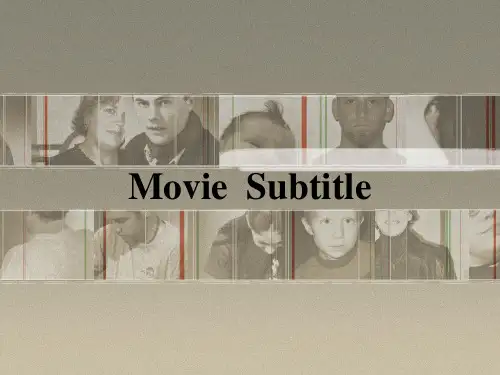
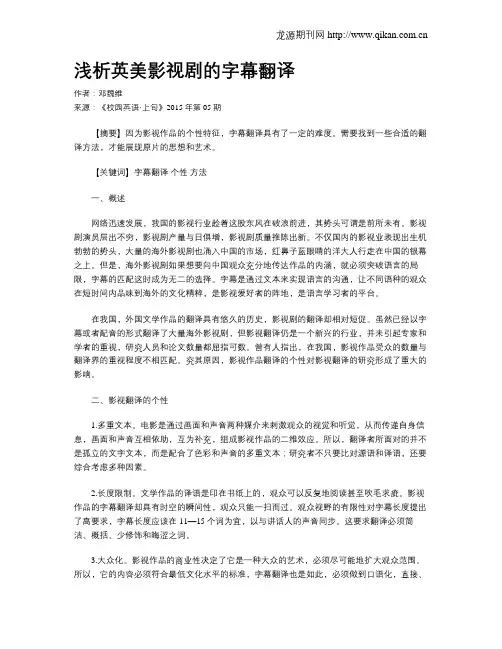
浅析英美影视剧的字幕翻译作者:邓魏维来源:《校园英语·上旬》2015年第05期【摘要】因为影视作品的个性特征,字幕翻译具有了一定的难度。
需要找到一些合适的翻译方法,才能展现原片的思想和艺术。
【关键词】字幕翻译个性方法一、概述网络迅速发展,我国的影视行业趁着这股东风在破浪前进,其势头可谓是前所未有。
影视剧演员层出不穷,影视剧产量与日俱增,影视剧质量推陈出新。
不仅国内的影视业表现出生机勃勃的势头,大量的海外影视剧也涌入中国的市场,红鼻子蓝眼睛的洋大人行走在中国的银幕之上。
但是,海外影视剧如果想要向中国观众充分地传达作品的内涵,就必须突破语言的局限,字幕的匹配这时成为无二的选择。
字幕是通过文本来实现语言的沟通,让不同语种的观众在短时间内品味到海外的文化精粹,是影视爱好者的阵地,是语言学习者的平台。
在我国,外国文学作品的翻译具有悠久的历史,影视剧的翻译却相对短促。
虽然已经以字幕或者配音的形式翻译了大量海外影视剧,但影视翻译仍是一个新兴的行业,并未引起专家和学者的重视,研究人员和论文数量都屈指可数。
曾有人指出,在我国,影视作品受众的数量与翻译界的重视程度不相匹配。
究其原因,影视作品翻译的个性对影视翻译的研究形成了重大的影响。
二、影视翻译的个性1.多重文本。
电影是通过画面和声音两种媒介来刺激观众的视觉和听觉,从而传递自身信息,画面和声音互相依助,互为补充,组成影视作品的二维效应。
所以,翻译者所面对的并不是孤立的文字文本,而是配合了色彩和声音的多重文本;研究者不只要比对源语和译语,还要综合考虑多种因素。
2.长度限制。
文学作品的译语是印在书纸上的,观众可以反复地阅读甚至吹毛求疵。
影视作品的字幕翻译却具有时空的瞬间性,观众只能一扫而过。
观众视野的有限性对字幕长度提出了高要求,字幕长度应该在11—15个词为宜,以与讲话人的声音同步。
这要求翻译必须简洁、概括、少修饰和晦涩之词。
3.大众化。
影视作品的商业性决定了它是一种大众的艺术,必须尽可能地扩大观众范围。
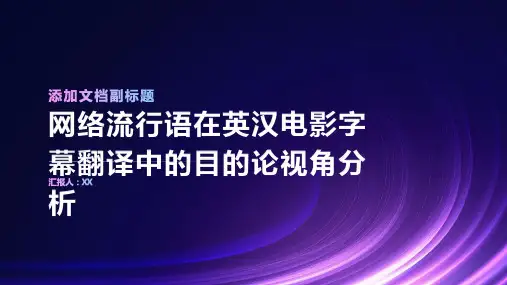
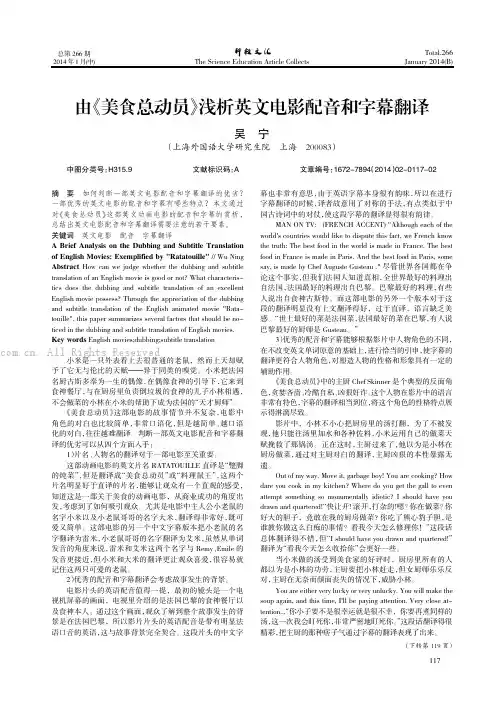
由《美食总动员》浅析英文电影配音和字幕翻译吴宁(上海外国语大学研究生院上海200083)中图分类号:H315.9文献标识码:A文章编号:1672-7894(2014)02-0117-02摘要如何判断一部英文电影配音和字幕翻译的优劣?一部优秀的英文电影的配音和字幕有哪些特点?本文通过对《美食总动员》这部英文动画电影的配音和字幕的赏析,总结出英文电影配音和字幕翻译需要注意的若干要素。
关键词英文电影配音字幕翻译A Brief Analysis on the Dubbing and Subtitle Translation of English Movies:Exemplified by"Ratatouille"//Wu Ning Abstract How can we judge whether the dubbing and subtitle translation of an English movie is good or not?What characteris-tics does the dubbing and subtitle translation of an excellent English movie possess?Through the appreciation of the dubbing and subtitle translation of the English animated movie"Rata-touille",this paper summarizes several factors that should be no-ticed in the dubbing and subtitle translation of English movies. Key words English movies;dubbing;subtitle translation小米是一只外表看上去很普通的老鼠,然而上天却赋予了它无与伦比的天赋———异于同类的嗅觉。
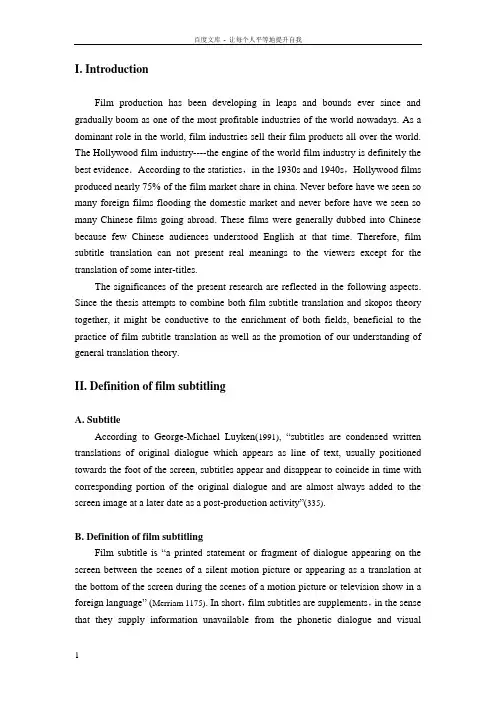
I. IntroductionFilm production has been developing in leaps and bounds ever since and gradually boom as one of the most profitable industries of the world nowadays. As a dominant role in the world, film industries sell their film products all over the world. The Hollywood film industry----the engine of the world film industry is definitely the best evidence.According to the statistics,in the 1930s and 1940s,Hollywood films produced nearly 75% of the film market share in china. Never before have we seen so many foreign films flooding the domestic market and never before have we seen so many Chinese films going abroad. These films were generally dubbed into Chinese because few Chinese audiences understood English at that time. Therefore, film subtitle translation can not present real meanings to the viewers except for the translation of some inter-titles.The significances of the present research are reflected in the following aspects. Since the thesis attempts to combine both film subtitle translation and skopos theory together, it might be conductive to the enrichment of both fields, beneficial to the practice of film subtitle translation as well as the promotion of our understanding of general translation theory.II. Definition of film subtitlingA. SubtitleAccording to George-Michael Luyken(1991), “subtitles are condensed written translations of original dialogue which appears as line of text, usually positioned towards the foot of the screen, subtitles appear and disappear to coincide in time with corresponding portion of the original dialogue and are almost always added to the screen image at a later date as a post-production activity”(335).B. Definition of film subtitlingFilm subtitle is “a printed statement or fragment of dialogue appearing on the screen between the scenes of a silent motion picture or appearing as a translation at the bottom of the screen during the scenes of a motion picture or television show in a foreign language” (Merriam 1175). In short,film subtitles are supplements,in the sense that they supply information unavailable from the phonetic dialogue and visualpicture.Film subtitles are different from “displays” or “captions”. “Displays” are “fragments of text recorded by the camera-letters, newspapers, headlines, banners etc” (Gottlieb l01-121). “Captions” (or “top titles”) are pieces of “textual information usually inserted by the program maker to identify names,places or dates relevant to the story line”(Luyken). This distinction is maintained here and “subtitles”do not include displays or captions, unless otherwise stated.Film subtitle can be both “intralingual”(and “vertical”), when the target language is the same as the source language, and “intralingual” (or “diagonal”), when the target language is different from the source language (Gottlieb 249-258). “Film subtitle”in this thesis is used to refer to interlingual film subtitle, unless otherwise stated.Film subtitle can be “open”, when the target text constitutes a physical part of the translated film and is transmitted together with the film sound and image,or “closed”, when the target text is stored in a digital/teletext format which is transmitted in as well as accessed via a separately coded channel at the discretion of the viewers(Gottlieb 247). In this thesis, “film subtitle”, refers to open film subtitle, unless otherwise stated.III. A brief introduction to skopostheorieA. The process of skoposSkopos is the Greek word for “aim” or “purpose” and was induced into translation theory in the 1970s by Hans J. Vermeer as a technical term for the purpose of a translation and of the action of translating skopos focuses on the purpose of the translation, which determines the translation methods and strategies that are to be employed in order to produce a functionally adequate result, the target text (TT), called the translatum by Vermeer (20-23). Therefore,in skopos theory,knowing why an source text (ST) is to be translated and what the function of the TT will be are crucial for the translator.In the 1970s there appeared a school in translation studies in Germany functionalism. Katharina Reiss firstly pointed out in his work Translation Criticism (2004). The representatives are Katharina Reiss, Hans J. Vermeer and Christiane Nord. They hold that translation is a kind of action with a purpose. This theory is first presented by Reiss and Vermeer in their book Grundlegung einer allgemeinen Translationstheorie (1984) (General Foundations of Translation Theory).Since 1978, German translation theorist H. J. Venneer, who breaks through thetraditional equivalence-based the theory that centers on source text,creates the skopostheories with the translation purpose or function of a translation as a general principle on the basis of theory of action(23-24). It is generally agreed now that translation is a type of human action. According to Vermeer, human action is intentional and purposeful behavior that takes place in a given situation, which modifies the situation at the same time (205-210). Skopos argues that the shape of target text should above all be determined by the function or “Skopos”that it is intended to fulfill in the target context.Vermeer believes that the purpose of a target text determines the translation strategies. In his opinion, the purpose of a target text, which is so important, is great extent decided by target readers, cultural background. In Hans J Vemeer’s Skopos and Commission in Translational Action(1989),Vemmer puts the Skopostheorie in this way:“Any form of translation action, including therefore translation itself, maybe conceived as an action, as the name implies. Any action has an aim, a purpose. The word Skopos, then, is a technical term for the aim or purpose of a translation.” In her book Translating as a Purposeful Activity: Functionalist Approaches Explained (2001), Christiane Nord defines the skopostheorie that “Skopos is a Greek word for purpose”(13-14). According to skopostheorie (the theory that applies the notion of Skopos to translation), the prime principle determining any translation process is the purpose (skopos) of the overall translational action. This fits in with intentionality being part of the very definition of any action.B. Three rules of the SkopostheorieSkopos theory involves three rules, i. e. skopos rule, coherence rule and fidelity rule, which will be discussed as follows.1. Skopos ruleVermeer postulates that as a general rule it must be the intended purpose of the target text that determines translation methods and strategies. From this postulate, he derives the skopos rule: Human action(and its subcategory:translation) is determined by its purpose(Skopos), and therefore it is a function of its purpose(Baker 236).Vermeer explains the Skopos rule in the following way,“Each text is produced for a given purpose and sho uld serve this purpose. The skopos rule thus reads as follows: translate/interpret/speak/write in a way that enables your text/translation to function in the situation in which it is used and withthe people who want to use it and precisely in the way they want it to function” (29).It is also pointed out that most translational actions allow a variety of skopos, which may be related to each other in a hierarchical order, and the translator should be able to justify their choice of a particular skopos in a given translational situation in translation, ., the skopos must be decided separately in each specific case.Skopos rule helps the translator solve the eternal dilemmas of free vs. faithful translation, dynamic vs. formal equivalence, and so on. Nord points out that the skopos of a particular translation task may require a “free” or a “faithful” translation, or anything between these two extremes, depending on the purpose for which the translation is needed. (29).2. The coherence ruleTwo further general rules are the coherence rule and the fidelity rule. The coherence rule stipulates that the target text must be sufficiently coherent to allow the intended users to comprehend it, given their assumed background knowledge and situational circumstances.The coherence rule, or in Vermeer’s terms, the standard of “intra-textual coherence” means “the receiver should be able to understand it: it should make sense in the communicative situation and culture in which it is received”(Nord 32). The coherence rule specifies that “a t ranslation should be acceptable in a sense that it is coherent with the receivers’ situation” (Nord 32).That is to say, the translator’s task is to produce a text that is at least likely to be meaningful to target-culture receivers, namely, to be coherent with the receivers’situation and thus to be understood by the receivers. Only when the receivers understand it as being sufficiently coherent with their situation, can this communicative interaction be regarded as successful.3. The fidelity ruleHowever, just being coherent with the target situation is not enough. A translation is an offer of information about a preceding offer of information; therefore there is a relationship between the translation and the source text. Vermeer calls this relationship “inter-textual coherence or “fidelity”. This is postulated as a further principle, referred to as the “fidelity rule” (Nord 32)“Inter-textual coherence should exist between source and target text, while the form it takes depends both on t he translator’s interpretation of the source text and on the translation skopos” (Nord 1-32). For example, one possible kind of inter-textualcoherence could be a maximally faithful imitation of the source text.We know that the source text is intended for the source culture receivers instead of translation,therefore when it is translated for the different target-culture recipients, maybe the function of the target text or the purpose of the translation is different from that of the source text. In this case,the “fidelity rule” should give way to the skopos rule. However, the translator should aim for any possible compatibility between the skopos and inter-textual coherence.The three basic rules of the skopostheorie are designed to govern the translator’s activities in the whole translation process. In most cases, due to the reason that the skopos of the translation is frequently likely to deviate from the intention of the corresponding source language text, a translation cannot satisfy the three rules at the same time.IV. Film subtitle translation of If You Are the One from the perspective of skopostheorieIn subtitle translation of If You Are the One, in particular, its skopos is determined by the intention of its director as the initiator and the expectation of the English speaking viewers as the receivers of the English subtitles; its shape is determined by its skopos and the subtitler. This part is to analyze how the factors mentioned above determine the skopos and shape of translated subtitles in If You Are the One, and how strategies are employed to fulfill its skopos.A. Brief review of the film If You Are the OneThe film for 2008, If You Are the One, stars Feng’s longtime collaborator, Ge You, as a man in his 40s, newly rich, looking to settle down and start a family. Having made an instant fortune through his sale of the Conflict Resolution Terminal 2008, middle-aged entrepreneur Qin Fen (Ge You) turns his attention to finding a wife. Using all online personals service, he auditions potential spouses, but few make a lasting impression. Qin Fen’s stalwart personality is partly to blame;he’s intent on finding a suitable match,and is willing to walk away from even an absolute goddess if there’s a hint of incompatibility. So it goes with comely flight attendant Smiley Liang (Shu Qi), who Qin Fen initially recognizes as a poor match. Regardless, the two commiserate over drinks, where the melancholy Smiley reveals that she’s dating amarried man (Alex Fong). The two parts intends never to meet again, with each returning to their own pursuit of love.But as fate and the screenwriters would have it, Qin Fen and Smiley meet again on all airline flight,with Smiley working, Qin Fen traveling, and Smiley’s boyfriend and wife also present. The coincidence draws Qin Fen and Smiley back together, propelling them on the road to friendship and perhaps more, with occasional stops at fine luxury entertainment locations, where they sip expensive drinks while verbally sparring over their views on love. Qin Fen aims for a home run with his potential mate, while Smiley seems willing to settle if she can’t have her idealized,unattainable love. In response, Qin Fen tries to convince her otherwise while attempting not to appear as he’s trying to. It’s the story of one man’s tough love, except with a picturesque tour of fabulous locations that only people with money can visit. Somewhere in there, Qin Fen’s loyalty and stalwart affection is supposed to comfort Smiley’s wounded heart or something like that.B. An analysis of subtitle translation of If You Are the One based on skoposIn subtitle translation of If You Are the One, in particular, its skopos is determined by the intention of its director Feng Xiaogang as the initiator and the expectation of the English-speaking viewers as the receivers of the English subtitles; its shape is determined by its skopos and the subtitler. This part is to analyze how the factors mentioned above determine the skopos and shape of translated subtitles in If You Are the One and how the strategies are employed to fulfill its skopos.1. Feng Xiaogang’s intentionFeng never denies his wish to defeat the Hollywood films at the box office by adapting Hollywood’s game rules (Rosen 336).Feng discloses that the Associate President of Columbia Pictures, once said to him, “Your films have never been shown in overseas countries and thus you are not known to the viewers outside your country.Big Shot’s Funeral serves as an advertisement to publicize you and I hope it can provide the foundation for your second and third film in the overseas market” (Feng 187). From Mr. Geris’s wish, we can also find F eng’s ambition to gain the market share in foreign countries. And the film If You Are the One has proved to be well received in the North American market.Feng recalls in his book that on a seminar about the making of Big Shot’s Funeral,some people asked him whether the production strategy of the film should beconsidered as Hollywood’s cultural invasion into Chinese film industry. He replies that “it is a win-win deal and a two-edged sword” and that this kind of cooperation is cost-efficient because it “still makes Chinese films,but faces the global market” (Feng 187). As for Feng Xiaogang, the way to revive domestic market and march into international market is to cooperate with foreign film production companies and internationalize domestic film success.From above,we can see that the director’s intention is to bridge the gap between Chinese and foreign cultures and gain market share in foreign countries,which is the major part of translation brief.2.Skopos analysisTo define the skopos, we should verify the translation brief. Although it is said that a brief should be given by the clients, more often than not, it is not the case. Then a translator should have the ability to verify it by himself. The translation brief of the present case could be specified as follows:a. The intended text functions: the main function of the TT is referential. If You Are the One is more a commercial movie than art,the intended text function is first of all referential, to provide information about what is going on the screen. Then it may come the expressive function to relay the sender’s attitude and feelings. The translator must weigh against different functions and decide on the main one. In the present case,it is the referential function that wins the upper hand. Translator has to make a choice according to the skopos of the translation of film subtitle. Feng’s film subtitle translation aims to win the target market so that translator has to produce clear and concise subtitled film dialogues bridging the cultural gaps and make the narrative easily accessible for the audience.Thus, the target audience will find it easier to accept and understand the translated subtitles. Here are some examples.(1)秦奋:不算老实但天生胆小I'm no angel杀人不犯法我也下不去手Just too cowardly to do wrongThe west and east have different religious beliefs. In Christianity, Angel is a good spirit who is kind, lovely and innocent. Here, Qin Fen describes himself as a man who is not well-behaved.So he is not like an angel.(2)别猫哭耗子了Spare me the alligator tearsIn China, there is a proverb“猫哭耗子假慈悲”. This means the cat pretends to be sympathetic to the death of the mouse because she can have it as a meal. In western culture, people think that while having meals, usually an animal, an alligator will shed tears. So alligator tears implies disguised sympathy.(3)有的人是情人眼里才是西施Beauty is in the eyes of the beholder不过分的说, 仇人眼里你都是西施But no exaggeration, even to a foe,you’d be beautifulThe above underlined words or proverbs are all culture-loaded. Domestication is adopted to make the western audience fully understand the film.b. The addressees:It is self-evident that the TT addressees in subtitle translation are the foreign audience, probably adults, who share a different culture background and who are lay of Chinese. To be specific, they are common people who watch it for entertainment and film festival juries who view it with a discerning eye, eg.秦奋:那咱俩要是结婚了So,if we get married非得倒插门我去你们那儿吗I have to go to live with your family?In China, in most cases,after marriage, the wife lives with the husband’s family. “倒插门”means the husband lives with wife’s family. In this sentence, it is deleted since it expresses the same meaning as “我去你们那儿”.c. The time and place of text reception: The time and space of reception is less controversial,which vary in different cases. In this case, the time is up to now from 2008 when it was released to the public and the place is at the very beginning cinema and later on amounts to a wide range of places thanks to the development of technologies such as DVD.So far, the skopos of the translation can be defined as to supplement the film by providing the optimal information for the audience in written form within a limited time and space.V. Film subtitle translation of Curse of the Golden Flower from the perspective of skopostheorieIn this part, the subtitle translation of Curse of the Golden Flower is analyzedwith the background of the skopos theory.A. Background of Curse of the Golden FlowerCurse of the Golden Flower is derived from the story Thunderstorm, one of the best-known masterpieces by the most famous Chinese playwright Cao Yu. But the adaptation doesn’t stay too faithful to the original. The film is a historical drama directed by Zhang Yimou who also co-wrote the screenplay in Chinese. The screen version is established in the 10th century during the short-1ived Late Tang Dynasty, about a thousand years ago.For today’s viewers,it is a story about court intrigues and deceptions. Moreover there are several pivotal factors within the plot, among which, traditional Chinese medicine is the foremost one since the Emperor in the film is gradually poisoning his wife, the Empress, by adding a deadly fungus to her medicine. Zhang Yimou the director gives his explanation of the arrangement that “as for the Emperor’s personality, well, he’d love to stay in the royal pharmacy all the time. He’s a drug freak. That’s how his character is developed and expanded upon. He’s just so into the drug”.B. An analysis of subtitle translation of Curse of the Golden Flower based onskoposThe title of the movie,which is literally translated as “The Whole City is Clothed in Golden Armor”, is the last line taken from a Tang Dynasty poem---Do not Endow with Chrysanthemum Behind written by Huang Chao who rose in rebellion in 875 and died 9 years later.After changing the title several times, the screenwriters as well as the director finally settle on the poem for the reason that it indicates the rebellion taken by the Prince against the Emperor in the movie. The Chinese audience may easily understand the cultural connotation while the English-speaking audience who are not familiar with the background of the poem, due to the great disparity in terms of cultural background, may not comprehend the implicit aspects of the title without the explanatory message or footnote. Consequently, this kind of culturally loaded expressions will put a lot of processing efforts on the target audience. In addition, with the constraints of time and space, if they focus on the reading of the subtitle, they will lose some of the visual and audio information.To solve this problem, the subtitler discards the Chinese title and adapts a new one with the image of the golden flower taken as a symbol to reveal the palace intrigue and the machination of power play to the target audience. The golden flower is designed to function as the symbol of rebellion, which is the same as the title. Hence its images appearing in the film once and again will, in another form, retrieve the loss of the culturally loaded information caused by the substitution since film is a multidimensional art involving visual images, sound, colors and so on. Let’s see some examples:(1)辰时的药煎好了Your Majesty’s medicine for the hour is ready(2)执令官统领后宫羽林军The Imperial Guards protect our private palacesIt is no easy job to translate cultural elements in subtitle translating. The underlined parts of the source text are omitted in the target text since these cultural elements do not deliver adequate information and there is no time to explain all details. Their function can be retrieved by the image and the subtitler is careful enough not to omit information that could at a later stage be essential for the understanding of the story.According to adequacy and equivalence theory, the translator can not offer the same amount and kind of information as the source-text producer. What the translator does is to offer another kind of information in another form (Reiss & Vermeer 123). Located in a broader ecological culture, the subtitling succeeds in producing a communicative interaction in the target text. We may find another example in this film:(3)当年你只是一个小小的都尉At that time,you were only a lowly captain.“都尉”here refers to the low-ranking officer in Tang Dynasty. If a simple transliteration as “Duwei”is adopted, it is completely meaningless to the English-speaking audience and fails to achieve intra-textual coherence. Whether to translate the complete meaning of “Duwei”, on the other hand, makes no difference to the comprehension of the plot for the source text producer just means that the Emperor mounts the throne from the bottom. Therefore the subtitler, by chunking it up, translates it into “a lowly captain” to establish inter-textual coherence as well as intra-textual coherence in the target text.(4)儿臣为了母后从此不再服药You will never drink the poison again.In the film, what the Empress drinks is a kind of Chinese medicine containing the ingredient that will cause a person to lose his or her entire mental faculty. According to traditional Chinese medicine, any medicine has 30% poison ingredients. Therefore some ingredients are useful as well as poisonous. Their curative value is restricted to certain diseases and certain dosage based on the theory of using poison to cure poison. These ingredients belong to the category of medicine despite of their toxicity. By chunking down the medicine into poison, the subtitler defines the meaning in the narrowest sense and makes the implicit information explicit to accomplish intra-textual coherence in the target text.VI. ConclusionA. ContributionSkopostheorie provides translators with a whole new perspective into translation action. This paper conducts a systematic analysis of crucial factors that influence the strategies of subtitle translation, in which skopostheorie is adopted to guide the descriptive and explanatory analysis.On the basis of the above analysis, this paper gets some enlightenment of skopostheorie on subtitle translation. The enlightenment of “intra-textual coherence”on subtitle translating is that the target receiver should be able to understand the translated version of subtitle. And the translated version should make sense in the communicative situation and culture in which it is received. The subtitler should always keep the target viewers in mind. After exploring the main components of skopostheorie and analyzing the specific constraints in film subtitle translation, the author tries to find out some enlightenment of skopostheorie on subtitle translation. In order to find out the enlightenment, this paper analyzes Feng Xiaogang’s film in light of skopostheorie. The film If You Are the One proves to be successful in its target market. Therefore, this paper tries to find out influencing factors that affect the subtitler’s choice of strategies.The author gives focus to the skopos of subtitle translation, the more influencing role of the film director in subtitle translation and the importance of target audience. With reference to skopostheorie,subtitle translating is a purposeful activity and thepurpose of the whole translational action is the prime principle that determines the translation process. The basic purpose or skopos of subtitle translation is to aid the viewers with a translated film dialogue, to provide them with the most relevant information in the most effective way within its specific constraints,to help them in understanding what’s happening on the screen with ease.B. LimitationsOwing to the limitations of time and space,the source data collected for the thesis is limited. Meanwhile because of the knowledge limitations this paper can not deeply analyzes the translation of Chinese film subtitles into English ones from the perspective of skopostheorie. It is the author’s sincere wish that if possible, in the future, further research can be done on comparative study on Chinese-English translation and English-Chinese translalion of film subtitles.Work CitedBaker, Mona. Routledge Encyclopeata of Translation Studies. Shanghai:Shanghai Foreign Language Education Press(2004):Baker,Christiane, Nord. Translating as a Purposeful Activity: Functional Approaches Explained.Shanghai: Shanghai Foreign Language Education Press, 2001.Feng, X. G[冯小刚]我把青春献给你武汉:长江文艺出版社2003: 187Gottlieb, H. Teaching Translation and Interpreting. Amsterdam: John Benjamins Publishing Company, 1998Gottlieb, H. Media Translation. Amsterdam/Philadelphia: John Benjamins Publishing Company, 2001Gottlieb, H. Subtitfing: Diagonal translation In C. Dollerup et al. (eds), Perspectives Studies in Translatology. Copenhagen: University of Cpenhagen, 1994 l01-121.Gottlieb, H. Anglicisms and TV Subtitles in an Anglified World: [A] Gambier Yves, 249-258 Gottlieb, H.Subtitling-a new university discipline in Teaching Translating and Interpreting. (eds) Dollerup, Cay&A. . Amsterdam: John Benjamin. 1998: 247Katharina, Reiss. Translation Criticism: The Potentials&Limitations. Shanghai: Shanghai Foreign Language Education Press, 2004.Katharina, Reiss and Hans J. Vermeer. Grundlegung einer allgemeinen Translationstheorie.Tubingen:Niemeyer, 1984,Michael. Overcoming Language Barriers in Television. [M] Manchester: European Institute forthe Media 1991.Luyken,George-Michael. Overcoming Language Barriers in Television. [M] Manchester: European Institute for the Media 1991.Merriam-Webster. Merriam Webster's Collegiate Dictionary. 1997:1175Rosen,S.(2002).狼来了:好莱坞与中国电影市场,. 全球化与中国影视的命运336-360. (S.Y Sun, Trans.). Shanghai: Shanghai Foreign Language Education Press. 1994-2000 Vermeer, Hans J. Skopos and Commission in Translational Action in Chesterman(ed). 1989, 20-233.。
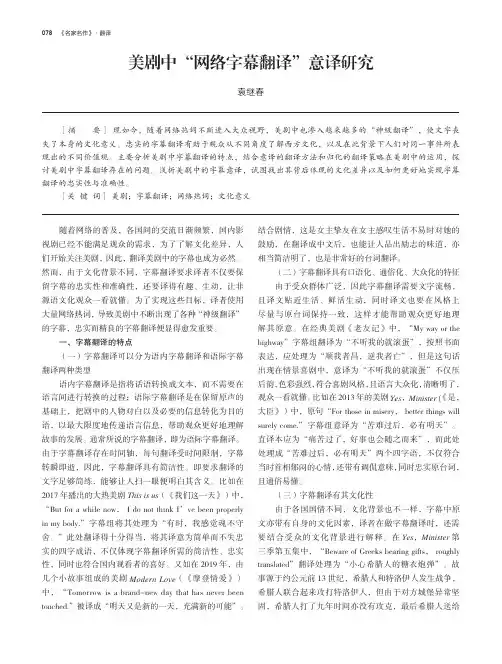
078《名家名作》·翻译[摘 要] 现如今,随着网络热词不断进入大众视野,美剧中也渗入越来越多的“神级翻译”,使文字丧失了本身的文化意义。
忠实的字幕翻译有助于观众从不同角度了解西方文化,以及在此背景下人们对同一事件所表现出的不同价值观。
主要分析美剧中字幕翻译的特点,结合意译的翻译方法和归化的翻译策略在美剧中的运用,探讨美剧中字幕翻译存在的问题。
浅析美剧中的字幕意译,试图找出其背后体现的文化差异以及如何更好地实现字幕翻译的忠实性与准确性。
[关 键 词] 美剧;字幕翻译;网络热词;文化意义美剧中“网络字幕翻译”意译研究袁继春随着网络的普及,各国间的交流日渐频繁,国内影视剧已经不能满足观众的需求,为了了解文化差异,人们开始关注美剧,因此,翻译美剧中的字幕也成为必然。
然而,由于文化背景不同,字幕翻译要求译者不仅要保留字幕的忠实性和准确性,还要译得有趣、生动,让非源语文化观众一看就懂。
为了实现这些目标,译者使用大量网络热词,导致美剧中不断出现了各种“神级翻译”的字幕,忠实而精良的字幕翻译便显得愈发重要。
一、字幕翻译的特点(一)字幕翻译可以分为语内字幕翻译和语际字幕翻译两种类型语内字幕翻译是指将话语转换成文本,而不需要在语言间进行转换的过程;语际字幕翻译是在保留原声的基础上,把剧中的人物对白以及必要的信息转化为目的语,以最大限度地传递语言信息,帮助观众更好地理解故事的发展。
通常所说的字幕翻译,即为语际字幕翻译。
由于字幕翻译存在时间轴,每句翻译受时间限制,字幕转瞬即逝,因此,字幕翻译具有简洁性。
即要求翻译的文字足够简练,能够让人扫一眼便明白其含义。
比如在2017年播出的大热美剧This is us (《我们这一天》)中,“But for a while now, I do not think I’ve been properly in my body.”字幕组将其处理为“有时,我感觉魂不守舍。
”此处翻译得十分得当,将其译意为简单而不失忠实的四字成语,不仅体现字幕翻译所需的简洁性、忠实性,同时也符合国内观看者的喜好。
外语电影字幕翻译评析【摘要】外语电影字幕翻译为电影观众充分了解世界文化打开了一扇重要窗户,但字幕翻译质量的好坏将直接影响观众对影片所要表达的思想及情感的理解和欣赏程度。
为此,通过对美国电影《闻香识女人》的字幕翻译评析来说明外语电影字幕翻译的准确性和得体性对电影观众理解、把握电影主题思想的重要性。
【关键词】电影字幕翻译;准确性;得体性;评析电影是现实生活的一个缩影,它通过塑造艺术形象表达一定的思想感情,包含了社会、历史、文化、风俗习惯、思维、宗教等方方面面的内容,可谓是包罗万象。
随着全球政治、经济一体化格局的不断推进,电影作为一种特殊的文化传播方式或跨文化交际方式,日益成为人们了解一个国家文化的重要途径,毋庸置疑,电影的字幕翻译也越来越受到翻译工作者的青睐和重视,日益成为越来越重要的新兴领域。
可以说,电影字幕翻译为电影观众打开了一扇了解世界的重要窗口,字幕翻译质量的好坏会直接影响观众对于影片所要表达的思想以及情感的理解和欣赏程度。
由此可见,电影字幕翻译的准确性和得体性就显得尤为重要。
目前,大量国外影片被引入中国电影市场,伴随着观众英语水平的不断提高,许多观众开始通过网络观看配有中文字幕或中英文字幕的原声电影,但是目前字幕翻译存在着良莠不齐的质量问题。
这在很大程度上影响了观众对于国外影片主题思想的正确把握和理解,甚至导致对原声电影内容的歪曲和误导,给观众造成了很大的负面影响。
电影是文学的一种特殊形式,电影应为观众而创作,并以观众的接受、欣赏和评判为生存的依据和标准。
因此,电影的特殊性就决定了其字幕翻译是目标取向策略。
下面就以电影《闻香识女人》为例,对其字幕翻译进行探讨和评析,从而加深对电影字幕翻译的理解和认识。
《闻香识女人》讲述的是一个发生在感恩节的两个男人之间的故事。
在感恩节前,在贵族学校上学的平民子弟查理,目睹了出身贵族的同学毁坏了校长的汽车,校长逼迫查理出来指证同学,并且以让他拿奖学金直升哈佛为诱饵逼供。
浅析电影字幕的翻译特色浅谈《国王的演讲》字幕翻译雷娜娜(渤海大学文理学院外语系)摘要:工业革命发明了电影,工业革命也促进了国与国之间的经济、政治、文化的交流。
中国随着现代改革开放的发展,经济、政治、文化得到高度繁荣发展,在发展的同时肯定会和外国文化发生交流,电影是国家之间文化交流的重要手段。
我们不能单纯的欣赏本国的电影艺术,也需要欣赏全世界的电影艺术。
中西方语言存在不同,为了更好的欣赏学习外国文化,就出现了影视翻译。
本文就《国王的演讲》影视字幕翻译的语言特色进行简要的论述。
关键词:影视字幕翻译大众化中国特色一、引言近些年,为了满足人们的精神生活需要,世界各国的电影事业得到了高速发展。
为了促进中西文化的交流,为了更全面的了解中西方世界,为了世界共同进步,世界各国之间相互引进优秀的电影以满足人们的艺术生活需要。
电影成为人们了解世界文化的讲解者和信息的传递者。
因此,电影字幕的翻译是无休止的话题,电影字幕也从低级向更高级发展,越来越符合接受者的需要。
二、影视字幕翻译的简要概括影视字幕翻译不相同于口译,也不相同于笔译,具有复杂性。
蒙娜·贝克曾经对影视作品这种符号合体作还原分析,把其分解为四个信道[1]P6:1.言语听觉信道,包括对话,背景语言,歌词等;2.非言语听觉信道,包括音乐,自然声响,音响;3.言语视觉信道,包括添加的字幕标题以及画面上出现的书面符号;4. 非言语视觉信道,即影片的画面构成及其播放流。
从形式上看,影视字幕是附录在电影中的文字,它可以不是原声中的语言文字。
也可以不是电影人物的对话文字,可以是一种独白,对电影产生解释补充的作用。
电影字幕必须和电影声音同步,否则就会带来混乱和困惑。
电影字幕还具有短暂性,只会在画面停留片刻。
电影字幕翻译是由口头语转向书面语,这一转向受到各种因素的影响,例如接受者的文化水平、接受国的文化差异等。
影视字幕的翻译同时影响了观看者对影视作品的接受理解,也影响到国与国之间的文化交流,影响世界文化的进步。
英文电影字幕翻译的技巧探析王雪菲(渤海大学辽宁锦州121000)㊀㊀摘要:在英语学习与实践的过程当中英语翻译是一个主要的应用方向ꎬ其中ꎬ英文电影字幕翻译由于翻译对象的特殊性ꎬ对翻译的技巧方面有着更高的要求ꎮ本文主要从英文电影字幕翻译的要求出发ꎬ探讨英文电影字幕翻译的技巧以及今后的提升策略ꎮ关键词:英文电影字幕翻译技巧中图分类号:H059㊀文献标识码:A㊀文章编号:1009-5349(2018)01-0027-03㊀㊀随着中西方交流范围的不断扩大ꎬ大量的欧美电影陆续进入我国ꎮ由于中西语言文化的不同ꎬ需要英语翻译者来实现中英之间的语言转换ꎮ英文电影字幕翻译已经成为一个产业ꎬ但是ꎬ如何科学有效地进行英文电影字幕翻译ꎬ是当前整个英文翻译领域所研究的主要方向ꎮ因此ꎬ本文结合英文电影字幕的特点探讨翻译技巧ꎬ对于促进英文电影字幕翻译的水平的提升ꎬ有着一定的积极意义ꎮ一㊁英文电影字幕的特点英文电影ꎬ主要是通过图像的方式ꎬ将相关的题材进行艺术化的呈现ꎮ从整体上来看ꎬ英文电影字幕主要呈现出以下几个方面的特点ꎮ首先ꎬ口语化的语言ꎮ目前ꎬ英文电影字幕翻译内容大部分都是对白ꎮ因此ꎬ其所使用的语言呈现出一定的口语化色彩ꎮ由于英语发音各地区有所不同ꎬ因此其在口语表达方面也会展现出一定的地方语言特色ꎮ在翻译过程当中注重电影字幕的口语化特点也是今后在英文电影字幕翻译过程当中需要考虑的主要方向ꎮ其次ꎬ英文电影字幕内容的多元化ꎮ在进行英文电影梳理后可以发现ꎬ英文电影在类型上是非常多元的ꎮ有科幻题材㊁爱情题材㊁战争犯罪题材以及惊悚题材电影等等ꎬ其字幕翻译涉及诸多领域的专业术语ꎮ因此ꎬ在英文电影字幕翻译过程当中ꎬ需要从电影的题材以及字幕的特点出发来选择相应的翻译技巧ꎮ二㊁英文电影字幕翻译的基本要求在英文电影字幕翻译的过程当中ꎬ需要满足以下几个方面的要求才能更好地达到预期的英文电影字幕翻译效果ꎮ首先ꎬ英文电影字幕翻译的效果性ꎮ电影是一种文化商品ꎮ电影字幕翻译的好坏ꎬ不仅影响着电影本身的传播ꎬ在很大层面上也影响着电影背后文化的传播ꎮ尤其是大量的电影需要开展海外销售ꎬ如果不能从当地的语言文化出发来进行相应的翻译匹配ꎬ会在一定层面上影响英文电影的播出与表达效果ꎮ所以 入乡随俗 是英文电影字幕翻译的一大要求ꎮ其次ꎬ英文电影字幕翻译的创新性ꎮ在每年的国际性电影评选中ꎬ对英文电影的剧本提出了很高的要求ꎮ在这个过程当中ꎬ英文电影字幕翻译发挥着非常重要的作用ꎮ一个佳片能够在电影节评选中获奖ꎬ其中一个非常主要的原因就是其电影字幕在翻译的过程当中呈现出了一定的创新性ꎬ也就是说有与众不同之处ꎮ所以ꎬ在今后的英文电影字幕翻译中也应该进行相应的创新㊁提升ꎮ总之ꎬ从英文电影字幕的翻译要求来看ꎬ在英文电影字幕翻译过程当中ꎬ既要注重结合目标语言的文化体系以及英文电影字幕本身的特点ꎬ还要考虑英文电影字幕翻译所具有的区域性特点等等ꎮ只有从上述几点上进行相应的提升ꎬ英文电影字幕翻译所呈现出来效果才会更加理想ꎮ三㊁英文电影字幕翻译技巧分析英文电影字幕的翻译技巧从本质上来看与其他类型的翻译有着很大的相似之处ꎮ但是ꎬ由于电影语言具有自身的一些特点ꎬ因此ꎬ在英文电影字幕翻译的过程当中ꎬ还应该从具体的电影语言情景出发来选择与运用相应的电影字幕翻译技巧ꎮ首先ꎬ直接翻译ꎮ直接翻译是英文电影字幕翻译的过程当中比较常见的一种翻译技巧ꎮ所谓的直接翻译ꎬ主要是对电影字幕的字面意思进行直接的翻译ꎮ但是ꎬ作为一种带有一定表演性质的语言ꎬ在准确翻译的同时ꎬ还应该在遣词造句方面做相应的推敲与拿捏ꎬ从而提高英文电影字幕翻译的表现力与感染力ꎮ例如ꎬ在电影«海上钢琴师»中有一段经典的独白ꎬ在翻译的过程当中ꎬ需要体会男主人公的内心情感ꎬ注重深层含义的翻译表达ꎮAllthatcity.Youjustcouldn'tseetheendtoit.Theend?Please?Youpleasejustshowmewhereitends?ItwaswhatIdidn'tsee.Youunderstandthat?WhatIdidn'tsee.Inallthatsprawlingcitytherewaseverythingexceptanend.Therewasnoend.WhatIdidnotseewaswherethewholethingcametoanend.Theendoftheworld.男主人公在说这番话的时候ꎬ充满了对不确定未来的焦虑与不安ꎬ因此ꎬ在翻译的过程当中ꎬ要从字里行间ꎬ表达出这种内在的心理层面的变化ꎮ这段话可以翻译为: 在那个世界ꎬ你很难看到它的尽头ꎬ尽头ꎬ你能告诉我尽72英文电影字幕翻译的技巧探析头在哪儿吗?我看不到ꎬ你能理解吗ꎬ你能理解我什么看不到吗?在那个熙熙攘攘的世界里面ꎬ什么都有就是没有尽头ꎬ我看不到一切都将在哪里结束ꎬ我看不到世界的尽头ꎮ 从这一段的翻译可以看出ꎬ好的翻译不一定就是优美的语句ꎬ有的时候ꎬ简单的㊁朴实的语言更有打动人心的力量ꎮ所以ꎬ在英文电影字幕翻译的过程当中ꎬ忠于字幕的原文采用简单的直接的表达也是一种重要的翻译技巧ꎮ其次ꎬ间接翻译ꎮ在英文电影字幕翻译的过程当中ꎬ除了通过直接的翻译来进行字面的表达之外ꎬ还需要结合电影字幕所要表达的含义以及中西方文化之间的差异采取间接的翻译的技巧ꎮ间接翻译的主要出发点有两个方面ꎮ一方面是英文电影字幕本身存在着一定的潜台词ꎬ如果直接翻译将导致观众难以理解字幕所要表达的真实意思ꎮ另一方面ꎬ某些英文电影对白直接翻译中国的观众不容易理解ꎮ在涉及这一类的英文电影字幕的翻译的时候ꎬ间接翻译是一种比较常见的英文电影字幕的技巧ꎮ例如ꎬ在电影«当幸福来敲门»中ꎬ黑人老爸有一句经典的台词ꎬ如果仅仅从字面的意思上来翻译将会影响翻译的效果ꎬ因此ꎬ需要借助间接翻译的技巧ꎮThereisanIin happiness ꎬThereisnoYin happiness ꎬIt'sanI ꎬ幸福的幸里面是一个 幸 ꎬ不是一个 辛 ꎮ或者理解成ꎬY=Why=为什么ꎬI=我ꎮ幸福里面没有为什么ꎬ只有我ꎮ从这个例子中可以看出ꎬ在英文电影翻译的过程当中ꎬ有一些的字幕内容与中文的语言体系之间是存在着一定的差距的ꎮ例如ꎬ在宗教与信仰方面ꎬ中西之间是存在着比较大的差距的ꎮ因此ꎬ为了达到更好的电影字幕的翻译效果ꎬ需要借助间接的方式来进行相应的翻译ꎮ最后ꎬ综合翻译ꎮ在英文电影字幕翻译的过程当中ꎬ由于诸多方面的原因ꎬ其字幕的内容会呈现出多元化的特点ꎮ因此ꎬ在这一背景下ꎬ进行英文电影字幕的翻译ꎬ不能简单地机械地使用某一种翻译技巧ꎬ例如ꎬ直接翻译或者间接翻译ꎬ而是需要将两者进行有机的结合ꎮ发挥直接翻译与间接翻译所具有的各自优势ꎬ来达到更好的翻译效果ꎮ总之ꎬ在英文电影字幕翻译的过程当中ꎬ科学地选择与应用翻译技巧所具有的作用正在不断地凸显ꎮ正如在翻译领域所流行的一句话所说的一样:翻译有法ꎬ但无定法ꎮ因此ꎬ在今后的英文电影字幕翻译的过程当中ꎬ应该根据英文电影字幕的特点来科学地选择相应的翻译技巧ꎮ只有这样ꎬ英文电影字幕翻译才会朝向更加科学的方向发展ꎮ四、英文电影字幕翻译提升策略在上文中主要探讨了英文电影字幕对翻译提出的具体要求ꎮ为了更好地提高英文电影字幕翻译的技巧水平ꎬ本文尝试从以下几个方面来进行探讨ꎮ首先ꎬ要考虑英文电影字幕翻译的文化性ꎮ电影是文化的表现形式ꎬ也是文化的载体ꎮ在今后进行英文电影字幕翻译的过程当中ꎬ要充分考虑电影背后所具有的文化特质ꎮ大量的英文电影在表达的过程当中ꎬ都带有一定的主题文化性色彩ꎮ所以ꎬ在英文电影字幕翻译的过程当中ꎬ要将字面翻译与电影本身所具有的文化底蕴与内涵有机地结合在一起ꎮ只有建立在一定的文化基础上的英文电影字幕翻译才会达到理想的效果ꎮ在今后的英文电影的字幕翻译的过程当中ꎬ无论是使用直接翻译的技巧ꎬ还是使用间接翻译的技巧ꎬ都应该重视中西之间在文化层面的差异性ꎬ在追求准确翻译的同时ꎬ提升翻译的文化性水平ꎬ从而助力电影在中西方文化交流中作用的发挥ꎮ伴随着世界一体化进程的加快ꎬ文化的共同发展也成为包括英文电影在内的诸多的文化载体所承载的重要使命ꎮ其次ꎬ要注意英文电影字幕翻译的本土化ꎮ目前ꎬ我国已经成为世界上主要的电影商品输入国ꎮ每年ꎬ我国都会引进大量的欧美大片ꎮ中国市场也正在引起世界上更多电影生产企业的重视ꎮ因此ꎬ做好英文电影字幕翻译ꎬ也是很多英文电影生产厂家所关注的主要问题ꎮ在进行英文电影字幕翻译过程当中ꎬ不仅要从字面的意思出发ꎬ进行准确的表达ꎬ还应该充分地结合英文电影字幕所要表达的主题来不断进行本土化发展ꎮ例如ꎬ有的英文电影在字幕翻译的过程当中ꎬ加入了很多中国特色的俚语和方言ꎬ让整个英文电影的幽默性和夸张效果得到了更好的彰显ꎮ在今后的英文电影字幕的翻译过程当中ꎬ只有不断使英文电影字幕翻译实现本土化发展ꎬ其所具有的翻译效果才会得到更好的提升ꎮ再次ꎬ要提高英文电影翻译者的综合知识储备能力ꎮ在英文电影字幕的翻译过程当中ꎬ翻译者所具有的综合知识能力水平高低ꎬ直接决定和影响着英文电影字幕翻译的水平ꎮ英语翻译本身就是一个复杂的翻译体系ꎮ英文电影字幕翻译者不仅要具备某一方面知识ꎬ还应该根据翻译对象的不同来对相应学科知识进行充电ꎮ比如ꎬ在科幻电影«地心引力»字幕的翻译过程当中ꎬ译者需要了解相关的太空航天术语ꎮ在涉及医学电影翻译时ꎬ也应该学习相关的医学术语ꎮ例如ꎬ奥斯卡获奖电影«海边的曼彻斯特»中有很多令人感伤的句子ꎮ在其字幕翻译的过程当中ꎬ还要结合主人公的心理译出那种孤独的凄凉ꎮ在翻译大型战争电影ꎬ例如«敦刻尔克»的时候ꎬ也要注重语言的历史标志性ꎮ所以ꎬ在英文电影字幕翻译的过程当中ꎬ要不断地提高翻译工作人员自身的综合文化素养以及相关词汇的广博性ꎮ这也是提高英文电影字幕翻译水平的题中应有之义ꎮ最后ꎬ要在实践基础上不断提升ꎮ在今后英文电影字幕翻译过程当中ꎬ要从整个翻译的效果性出发ꎬ不断地选择最佳的翻译方案ꎬ最终实现 信㊁达㊁雅 的翻译技巧的综合体现ꎮ在英文电影字幕翻译水平与技巧提升过程当中ꎬ要充分认识到:英文电影字幕翻译是一个反复的过程ꎮ(下转第26页)随着时间的变化以及社会的不断进步与发展ꎬ尤其是在互联网科技不断发展的今天ꎬ大量的网络热词和流行语也逐渐成为习语来源的主要组成部分ꎮ英语习语作为英语语言体系的一部分ꎬ也不例外ꎮ尤其是随着现代网络社交媒体的快速发展ꎬ大量的网络流行语逐渐并入英语的习语体系ꎬ使得整个英语习语的总量处于一个动态的发展之中ꎮ所以ꎬ在今后的英语习语的学习与应用的过程当中ꎬ应该拥有更为开放的心态ꎬ对新生的习语有着更多的包容性ꎬ不断扩展自己的习语的范围ꎬ在创新的学习过程当中去感受英语习语与西方文化之间的深刻渊源ꎮ四㊁结语本文对英语习语和西方文化的关系的总结可以为今后英语习语的学习提供必要的借鉴ꎮ当然ꎬ由于研究的水平有限ꎬ在论述的过程当中ꎬ对于习语的界定与分类还需要进一步确定与完善ꎬ恳请相关的专家予以批评指正ꎮ参考文献:[1]赵芬艳.试论英语习语的特点及文化内涵[J].太原大学教育学院学报ꎬ2014(2).[2]顾宝珠ꎬ张恒ꎬ王国辉.浅谈英语习语与英语国家节日民俗[J].承德石油高等专科学校学报ꎬ2014(3). [3]费广会.初探大学生学好英语习语的策略[J].学周刊ꎬ2014(19).[4]崔超.浅谈风俗习惯对英语习语的影响[J].商业文化(下半月)ꎬ2012(1).[5]杨娟.浅议英语习语的特征及翻译[J].英语广场(学术研究)ꎬ2012(6).[6]沈刚.论英语习语的特点及其应用[J].阜阳师范学院学报(社会科学版)ꎬ2012(5).[7]贺音.文化差异下英语习语的翻译技巧[J].太原城市职业技术学院学报ꎬ2011(2).[8]董应武.试探英语习语之源[J].中国电力教育ꎬ2011(11).[9]高晓薇.文化差异视域下英语习语的内涵解析及翻译策略研究[J].重庆科技学院学报(社会科学版)ꎬ2011(12).[10]王涛.英语习语初探[J].湖南农机ꎬ2011(5).责任编辑:韩㊀丹(上接第28页)因此要允许犯错误并为其提供足够的空间来自由发挥ꎮ在这个过程当中ꎬ译者可以根据自己的翻译特点与名家的翻译结果进行比对ꎬ从而发现自己在英文电影字幕翻译中存在的不足ꎬ在此基础上进行相应的改进与提高ꎮ只有建立在反复实践㊁反复试错的基础上ꎬ英文电影字幕翻译水平才会得到相应的提升ꎮ另外ꎬ还应该积极引导英文电影字幕翻译学习者多实践㊁主动实践ꎮ通过翻译理论与翻译实践的良性互动来为今后英文电影字幕翻译水平的改观提供更大的支持与助力ꎮ总之ꎬ在今后的英文电影字幕的翻译过程当中ꎬ应该在翻译的文化性㊁翻译的本土化㊁翻译人员的综合素养以及翻译的实践水平上进行系统的改进与提升ꎮ我国对英文电影需求数量与需求质量的不断提升ꎬ对英文电影字幕翻译也提出了更高的要求ꎮ因此ꎬ在今后的英文学习以及英文电影字幕的翻译过程当中ꎬ如何从英文电影字幕翻译的需要出发来进行相应的改进ꎬ已经成为当前英语翻译研究与实践领域所关注的主要问题ꎮ五㊁结语本文主要探讨了英文电影字幕的特点以及对翻译的具体要求ꎮ如何有效地提高英文电影字幕翻译的水平是当前英语翻译应用领域研究的主要方向ꎮ希望本文的研究能够助力于英文电影字幕翻译研究理论的完善ꎮ参考文献:[1]王焰ꎬ郑贤贵.电影字幕翻译的微技巧探析[J].西南民族大学学报(人文社科版)ꎬ2005ꎬ26(10):297-299.[2]李霞ꎬ熊东萍.英文电影的字幕翻译技巧探讨[J].电影文学ꎬ2008ꎬNo.464(11):117-118. [3]韦运会.论英文电影字幕翻译的基本要素与方法[J].电影文学ꎬ2012ꎬNo.561(12):154-155. [4]何科育.论文化差异性与英文电影字幕翻译策略[J].电影文学ꎬ2011ꎬNo.539(14):155-156. [5]吕吉瑛.电影字幕翻译的策略 以英文电影汉译为例[J].电影文学ꎬ2008ꎬNo.458(5):109-110.责任编辑:韩㊀丹。